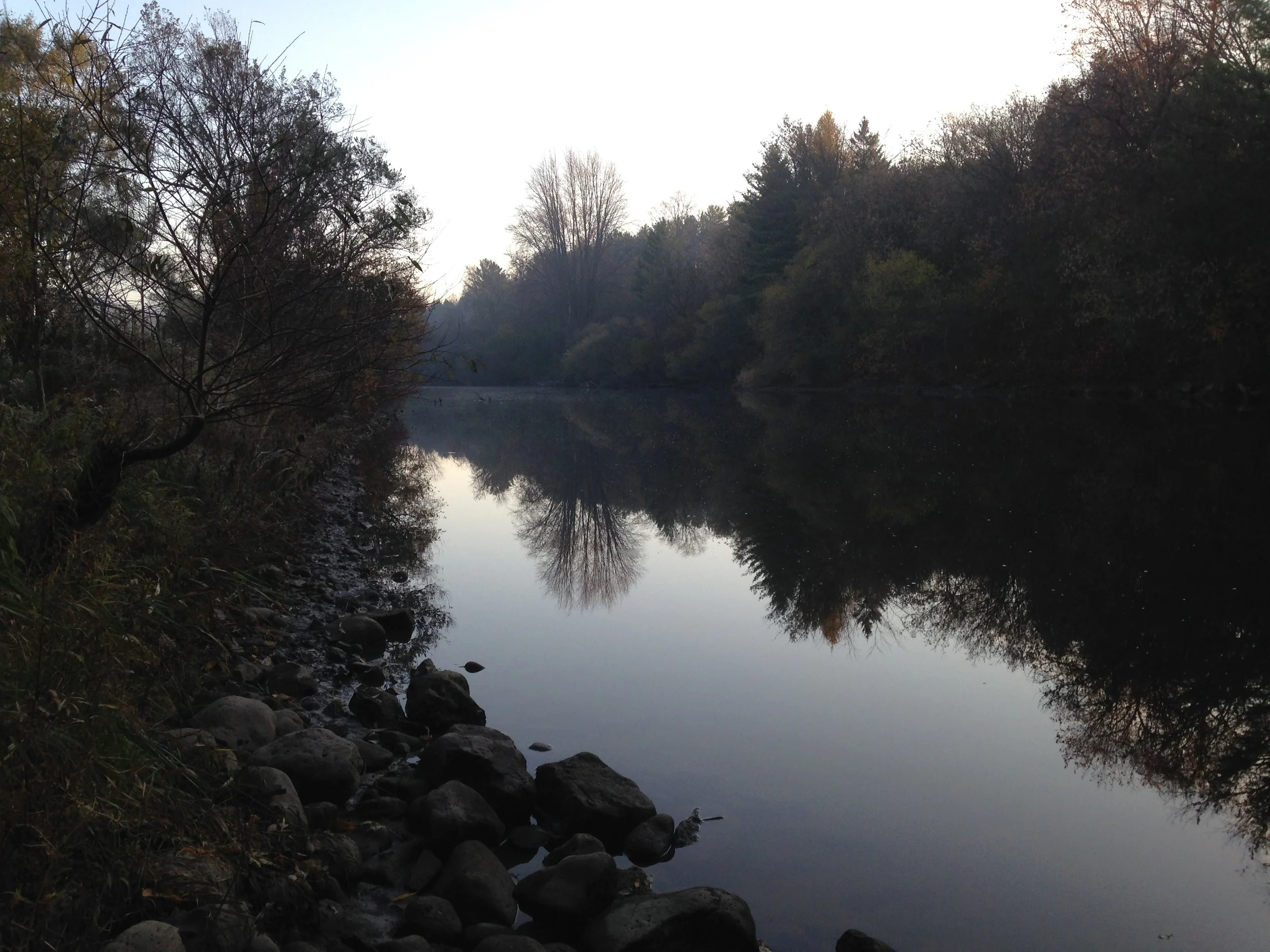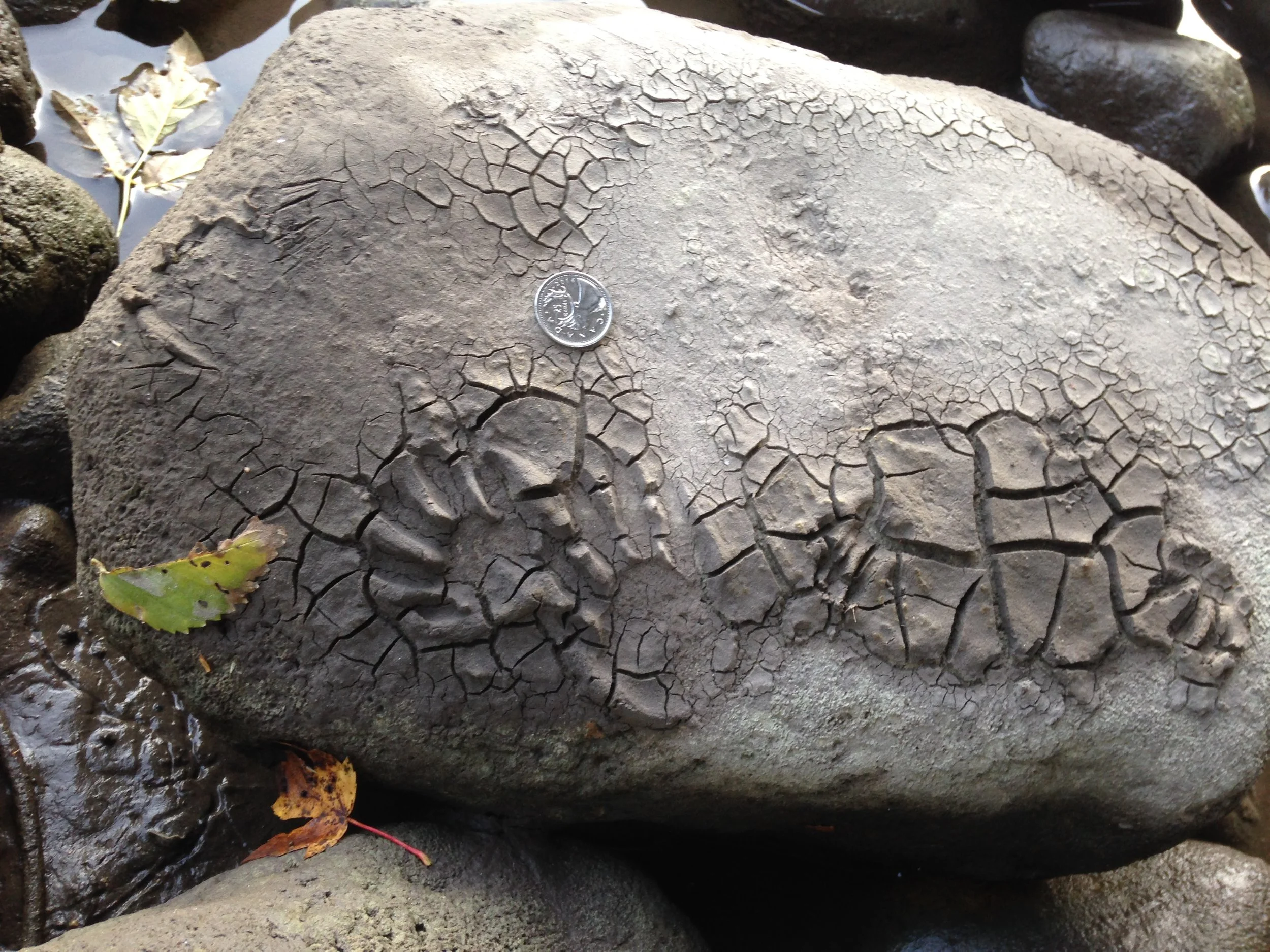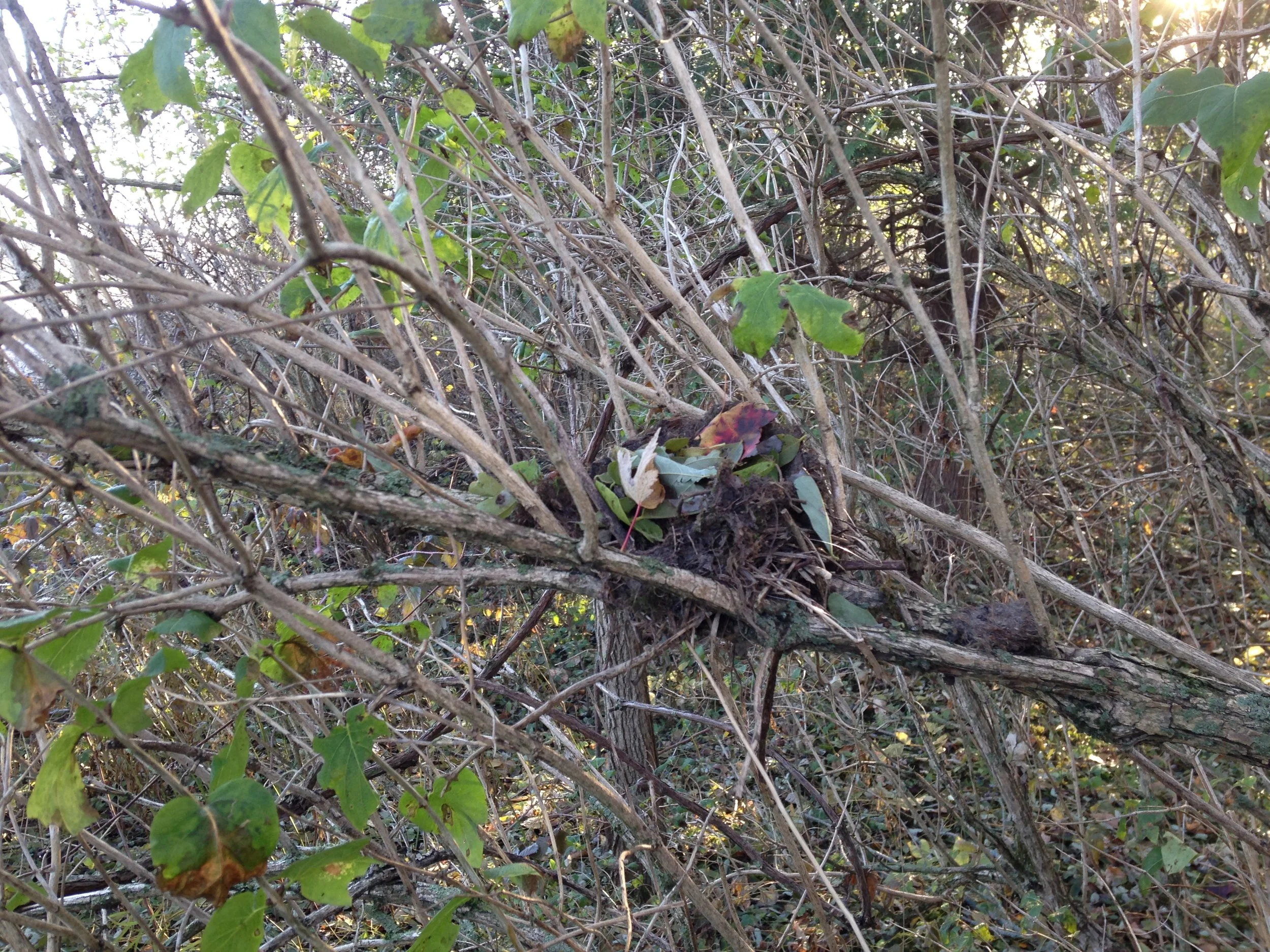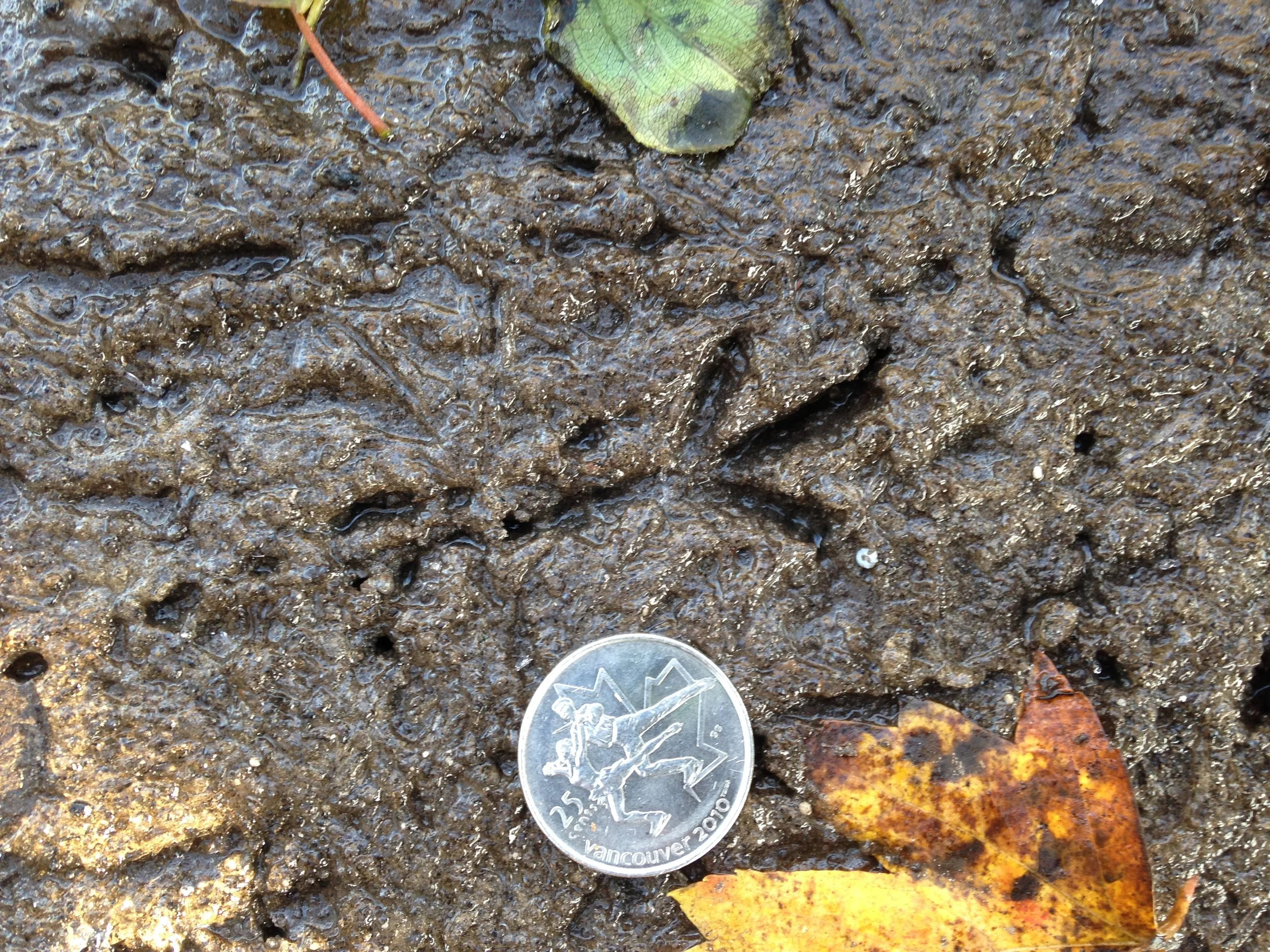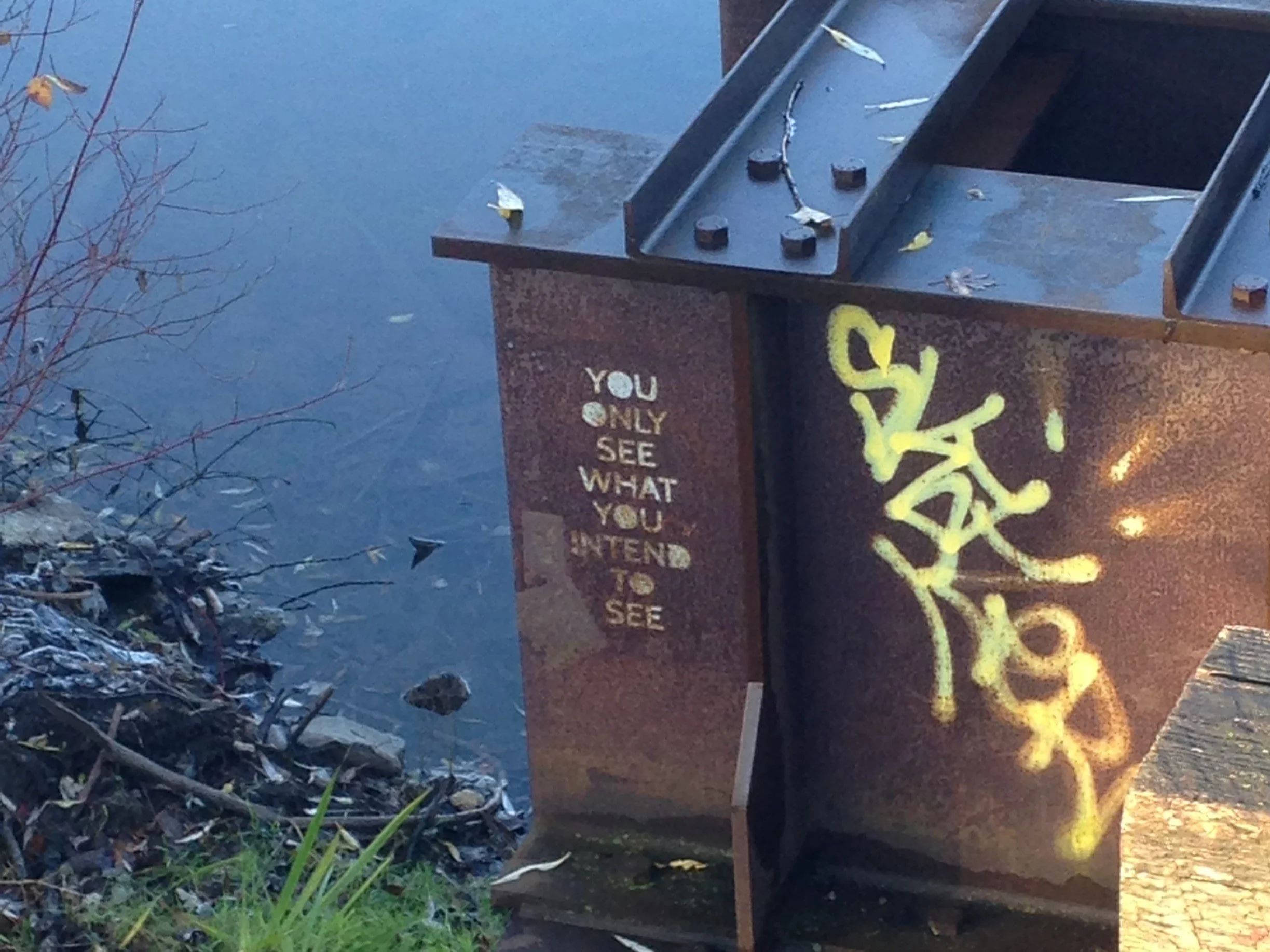Tracking journal for 2021.11.07
I woke up “early” because of the time change and realized I had some time before any other commitments for the day so I checked to see if anyone wanted to come out with me to go see the morning world. No one did, so like many other mornings, it was time to be spent between myself and the land around me. Perfect.
Looking Easterly along the Eramosa River
I left the house without intention beyond wanting to just get out and see something I hadn’t seen yet. That was all… and maybe check out a few nests. Tis the season for nests. The leaves have mostly dropped and the newly revealed architectures would be available for all with the eyes to spot them. I personally have bad eyes, but I wanted to at least try and spot a couple of nests. In fact, the new Peterson Field Guide to North American Bird Nests was the only field guide I packed in my bag that morning. The hope was there, but I had to get out looking as well to make the hope come true.
I went down to the Eramosa River as it is close by and life likes water so I would be sure to find something there, and immediately I did. I noticed Pigeon (Columba livia) feathers littered around from the Pigeons who roost in the girders over the water. Sometimes there are bloodied feathers, or even mangled Pigeon corpses left behind by wandering animals who ate and left some bits behind, but this time it was just moulted feathers laying in the mud. But there were other things to be found in the mud and on the rocks nearby.
Old Raccoon (Procyon lotor) tracks in cracked mud on the banks of the river
In the mud were some fresh tracks from Grey Squirrels (Sciurus carolinensis), domestic Dogs (Canis lupus familiaris), and Raccoons (Procyon lotor). While I do get interested in Squirrels and their sign, most of the time I still get a little more fixated on the larger creatures, especially the wilder ones. The Raccoon tracks were fun to look at because even though I know there are Raccoons in the area, and I have seen many throughout the years of visiting along this stretch of river, it is always thrilling to see more sign from them, to be reminded of their ongoing habitation of the area. This is their home, their sign written on the land more often than my own in those parts. I am walking in their space and I am the guest. I feel humbled and reminded that humans only occupy so much; There are still spaces which wilder creatures claim.
I looked at the fresh Raccoon tracks but the oldest ones, imprinted in mud on the side of a large rock were definitely my favorite. This must have been a large individual, maybe even the mother I had seen while canoeing last year, guiding her 7 young ones across the river at sundown. It was an amazing sight in the dusk, and I am grateful to have been canoeing by at just the right time. In studying the old track on the rock I got to wondering how I could tell if these were rights or lefts? The fingers seemed to curve a little with the tips pointing a little more towards the right than where they attach to the hand. Could this be a left front and hind gripping the rock to stand atop, or is it the right front and hind pushing off and the Raccoon making their way towards the left side of the image? I still can’t tell yet just by looking at these tracks in the mud, but I will be keeping this question in mind as I look for, and inevitably find more Raccoon tracks throughout the rest of the autumn and into winter.
After the Raccoon tracks I kept walking. I watched a male Cardinal (Cardinalis cardinalis) flit above me doing his companion/alarm calls for second before taking off across the river. I payed more attention from then on for possible birds in the Cattails (Typha latifolia) over the fence to the left of the trail. There were also Elm Oyster Mushrooms (Hypsizygus ulmarius) growing out of the Manitoba Maples (Acer negundo) which had fallen across the trail. I sort of petted them as I walked by wondering how they handled the colder nights. It had been 0°C early that morning, and -5°C the night before. Does this affect their growth in any way? How about the fruit, will a frost harm them, cause them to shrivel and decay faster? What about flavour? I havn’t eaten an Elm Oyster yet, even though they have been abundant this year. I just didn’t feel the compulsion. After stroking a couple more I kept on.
I got out of the winding riparian path through the scrubby woods and got to the train tracks. I decided to try and walk as quiet as I could over the stone and slag as I often see unusual birds along a stream on the far side of the tracks, and sometimes Muskrats (Ondatra zibethicus) and Mink (Neogale vison). This time though, there was nothing but some ripples in the water beneath a Dogwood (Cornus sp.) at the edge of the stream. This particular stream followed the tracks and eventually led back to the river a few dozen meters up the way so I continued on watching some birds flit about, alarming to each other, letting everyone know I was there. Despite trying to keep quiet my presence was felt and known by all in listening range.
The bridge ahead has always been an attractant to me. It crosses over just down river from a wide shallow spot where Canada Geese (Branta canadensis), Great Blue Herons (Ardea herodias), Common Mergansers (Mergus merganser), and Buffleheads (Bucephala albeola) often drop by throughout the year. I have also seen more Raccoon tracks and Mink tracks at the shoreline under the bridge in previous visits and was hoping to see more perhaps on this visit, but instead I found some beautiful tracks in the frost on top of the bridge.
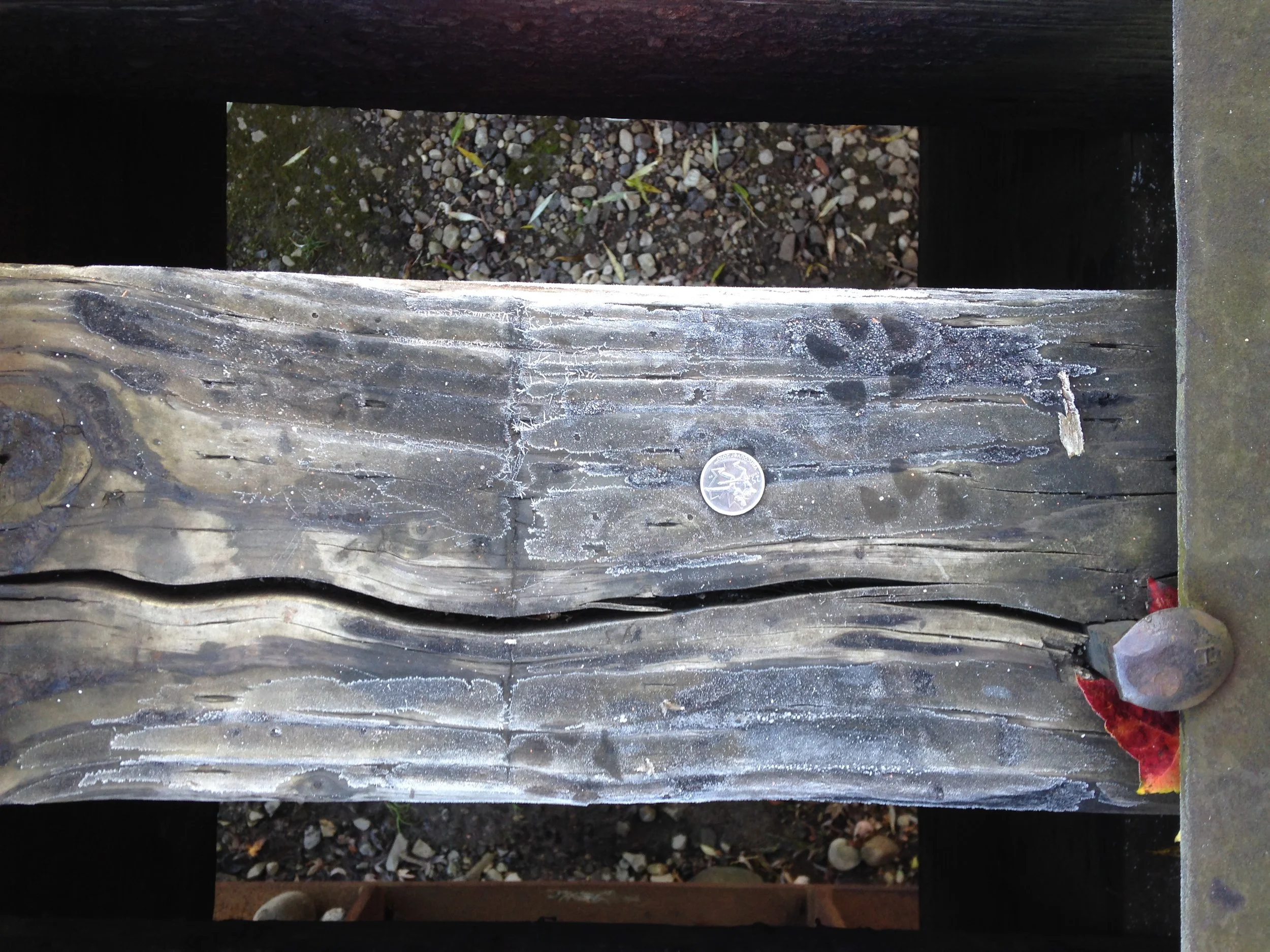
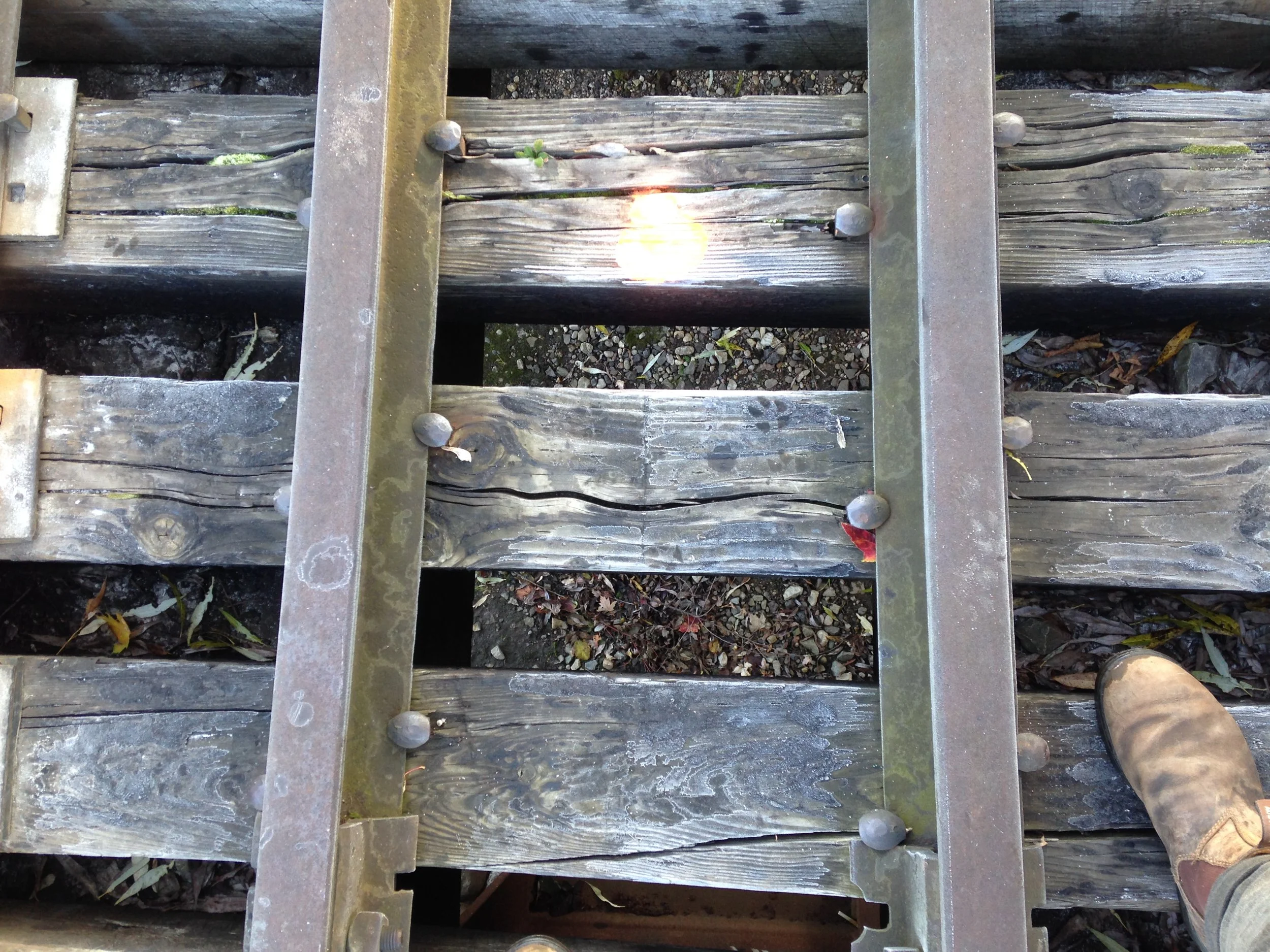

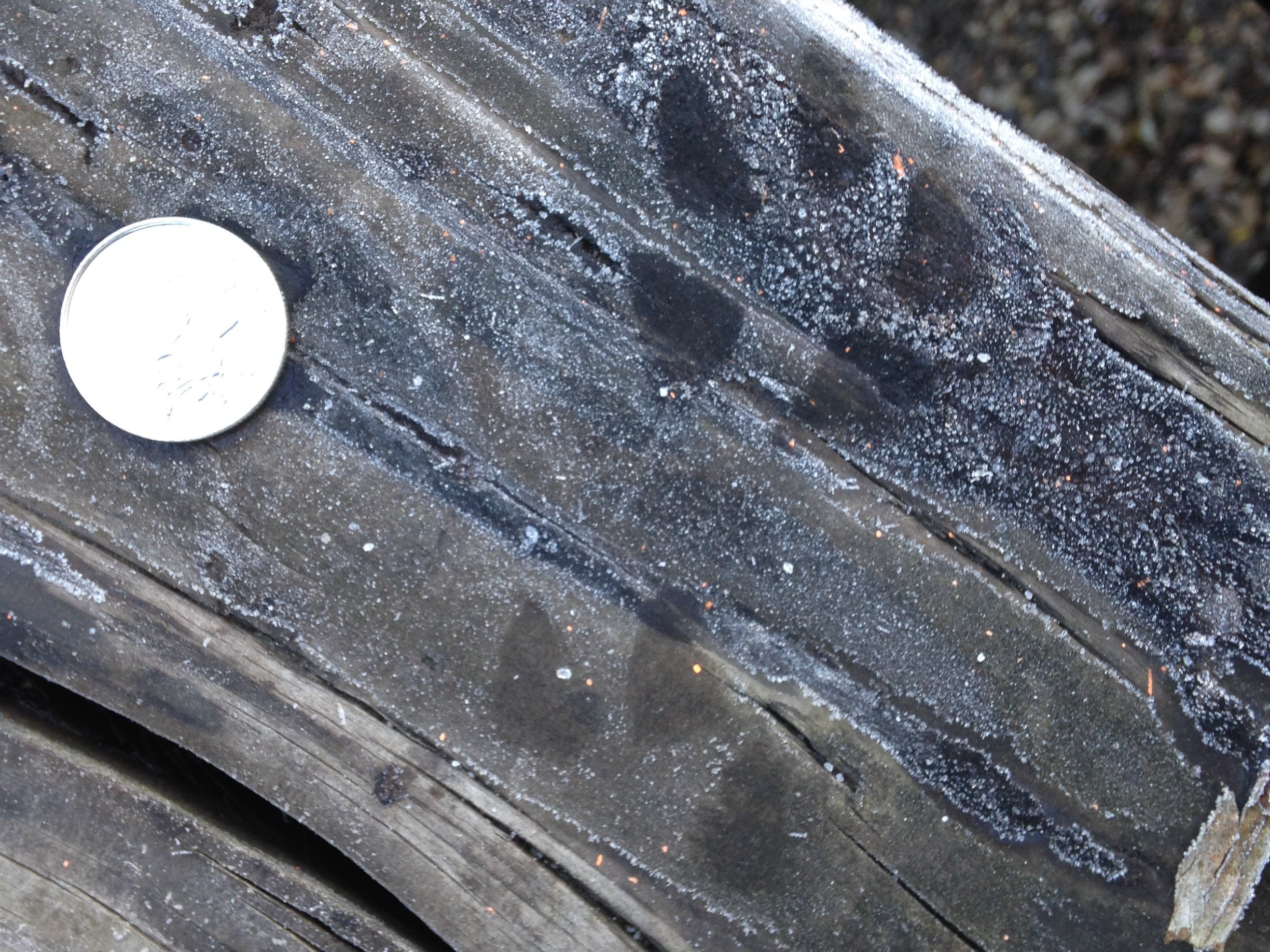
The toes and the heel pads (metacarpal/metatarsal pads) really show that this was a Red Fox (Vulpes vulpes). The pointy toes with the broad negative space, thin heel metacarpal on the front foot with a nearly flat line across the bottom; from what I have seen over the past few years, these are iconic Fox tracks particularly beautifully inscribed in the frost. It was a joy to find these. I followed them trying to navigate what I believed the be the trail but it seemed to me like the Fox was wandering about, exploring and checking out nooks and crannies along between the rails and ties on the East side of the bridge. It was certainly hard to follow where the Fox had gone when they left the bridge, looking for tracks on frost in the gravel wasn’t easy, nor rewarding. The expanse of options was also difficult. The bridge narrowed the options to a few select places where the Fox could actually walk so it was certainly easier. I got to wondering what a Fox’s home range might look like, as in, how big a territory might they wander? I imagine it changes based on geography. An urban Fox would have a different range than a rural Fox, I expect. I have read, in the context of urban Foxes in the UK, that the home range may be about four hectares (ha)—almost 10 acres, but then I got to wondering if this individual was wandering through a home range, or passing through in their dispersal from the home den? I was thinking that maybe this exploratory behaviour on the bridge might have been an indicator that the Fox didn’t know the bridge well, maybe thought to cross there, but was put off by the river below, so turned around? If they didn’t know the bridge, than maybe they didn’t know the area? Why wouldn’t they know the area? Maybe it was a dispersing Fox? Donna Naughton in her book “The Natural History of Canadian Mammals” writes that Red Foxes typically disperse 3-4 months old. That would generally mean July-August around here. So the next question would be how long does it take a Fox to find a home territory? Are they similar to Coyotes where there might be vagrants who just wander through? Or was it even a dispersing Fox anyways? Could they have just been curious about the bridge and went back to the land? I imagine lots of animals cross that bridge. I cross it a few times a month. I imagine dog walkers do, and perhaps even other critters. There has certainly been Opossum (Didelphis virginiana) tracks nearby, and likely others so why couldn’t that Fox been sniffing out other passersby wondering after potential prey? Sometimes… most of the time, I come home with more questions than answers. But this is ok. The mysteries goad me into researching more and I end up learning something new… hopefully.
I eventually left the bridge and walked on. I passed by an old nest in a Honeysuckle shrub and noted that it was the one I had first seen on December 5th last year. It was much more disheveled then before, having worn through the weather of the past year. I was amazed though at how the muddy base had stood up to the weather, and how intact it all was. I noted that the outer rim of grasses, mosses and twigs had a dilapidated look but again the mud was pretty intact on just over half of the nest. I wonder if some creature, possibly human (Homo sapiens) had ripped off half of the nest while trying to investigate it? I took some photos so I could compare in the future and practice aging a nest by looking at it and I moved on back across the tracks on towards the river.
I spooked a Rabbit (Sylvilagus floridanus) from where ever they had been hanging out and I quickly got down on my hands and knees feeling the now defrosted leaves for signs of warmth. I was pressing my hands against any perceived depression in the leaf litter hoping I would find the spot where they’d been feeding or sleeping or whatever it was they had been doing before I banged my way into their woods. I was thoroughly unsuccessful, but I did get my jeans all muddy so there was a bit of success. I noticed the remains of an old encampment near the rivers edge. I was concerned that if there was someone there, I get caught splayed out fumbling on the ground slapping the wet leaves… I would look like a bad tracker or something. So I got up and made my way for the waters edge.
There were Mink tracks, Raccoon tracks, Red Squirrel (Tamiasciurus hudsonicus) and tracks from a bird. I thought I knew, but I always get the doubts so I bent down low and took some measurements while checking out the overall shape and context. The stride length was about 9.5-10 cm throughout the trail that was clear enough to measure. I also noticed that the tracks appeared together at the beginning of the pictured trail and then the feet had landed alternately as the bird made their way. This showed me that the bird was walking, skipping, or running and not hopping at this moment. Many birds ambulate by hopping only, while others don’t hop at all. A few do both. I had an idea forming in my mind of who this bird might be, or maybe I was beginning to exclude who this wasn’t. Next I measured the individual tracks, and they ranged at 4.4 - 4.5 cm long x 2.2 - 2.5 cm wide. While this seemed to be on the low end of an America Robin (Turdus migratorius) in regards to the length of the track, they still fit within the range, and when considering the width, they were on the higher end.
I ended up asking a group online to confirm Robin, and someone suggested that they could be the tracks of a Sparrow of some sort, skipping in the mud. I do not remember ever seeing Sparrow skipping tracks before, but from what I have read in Bird Tracks and Sign by Mark Elbroch and Eleanor Marks, these tracks were a little large for a Song Sparrow (Melospiza melodia). As for the suggestion of skipping, I think skipping tracks look different than running tracks. Running tracks show the feet alternating with gaps between each foot, or as Mark and Eleanor put it “single tracks at alternating intervals”. I have been having a difficult time understanding (therefore putting it into my own words) the concept of a skipping bird. I’ll just quote Mark and Eleanor:
In skipping trails, track are also paired, but each foot lands independently of the other. A trail pattern is a skip rather than a hop when one foot registers completely in front of the other. Birds that skip tend to be small perching birds that nevertheless spend a great deal of time on the ground, such as snow buntings [sic] and song sparrows. One theory suggests that placing the feet in this way, rather than right next to each other, increases maneuverability.
When you see a bird skipping, it stays very low to the ground, which can give the impression of running. The head of the bird remains nearly level, and all the rotation comes from the lower body and legs. Both feet rotate forward, one foot strikes down, and as the body moves forward over this foot, the second foot touches down. The momentum continues propelling the body forward over the second foot, while the first foot lifts up behind the bird. Continuing forward, the second foot joins the first behind the bird, lifts off, and together they rotate forward for another cycle. Momentum is horizontal, and little energy is wasted with vertical rise. Strides in skip trails are measured exactly like those of hopping trails, from the tip of the leading track in a pair to the tip of the leading track of the next pair. Trail width is measured straight across the pair and will be noticeably narrower than that of hop trails. Do not measure at an angle, as this will greatly increase and distort the measurements. As paired tracks spread farther apart in skipping trails, they could be mistaken for a run at a glance. Measurements will make this clear.
- from Bird Tracks and Sign by Mark Elbroch and Eleanor Marks, (2001)
After reading this through a few times, I am still uncertain between Robin and Sparrow, and I keep wavering between the two. I’ll for sure be on the lookout this winter for Song Sparrow or White-throated Sparrow (Zonotrichia albicollis) tracks in the snow, along with more Robin tracks. Hopefully I can learn to see some of the differences and share what I find here.
I moved along the edge of the river, ducking under the Common Buckthorn (Rhamnus cathartica) and through the Stinging Nettle (Urtica dioica) stalks and came across an area which I knew. I had been there before, years previous, with my partner, but we had arrived by canoe. Then, we had brought the canoe to shore and I made my way through green Nettles almost as tall as I was until I felt as if I was in a spot that little risk of permanent flooding or being washed away, and I planted an Elderberry (Sambucus nigra) in hopes that it would grow. I can’t remember which year that was as my partner and I have been propagating Elders and planting them out for a few years now, but it was a while ago. When I returned this time, the other Elderberries, presumably S. canadensis, had lost all of their foliage but one plant with only a few leaflets remaining, while the one we planted was still in leaf. I guess some of the cuttings we’d propagated that year were from S. nigra parents (assuming the non-native varieties will retain their leaves longer, but this is just an assumption). This got me wondering if there is a visible or chemical difference between the two, S. nigra ssp. canadensis and S. nigra ssp. nigra. Turns out there isn’t much. The S. nigra ssp. canadensis may have acylated anthocyanins, which may make it better for consumption, but really my chemistry knowledge is very little, and I am not even sure what acylated anthocyanins are. Anthocyanins are pigments which are found in foods, which may act as anti-inflammatories, anti-oxidants ——
I began writing this blog entry on Nov 8th 2021. I didn’t finish it and went on to write about learning to tell the difference between different snails in the Cepaea genus.
It is now Nov 8th 2022. I thought that there was so much here that I wouldn’t mind coming back to, to learn more about the Raccoon, Fox and Robin tracks, that I couldn’t just leave it as a draft, even if unfinished. I hope it was worth it. There was one thing worth adding though, from the folder of images from the day I found while trying to recall any more information. It was some graffiti stenciled on the bridge where I saw the Fox tracks in the frost. It could be my maxim for tracking outings in general, or just a gentle reminder to keep my eyes, mind and heart open, just in case of the unexpected.

